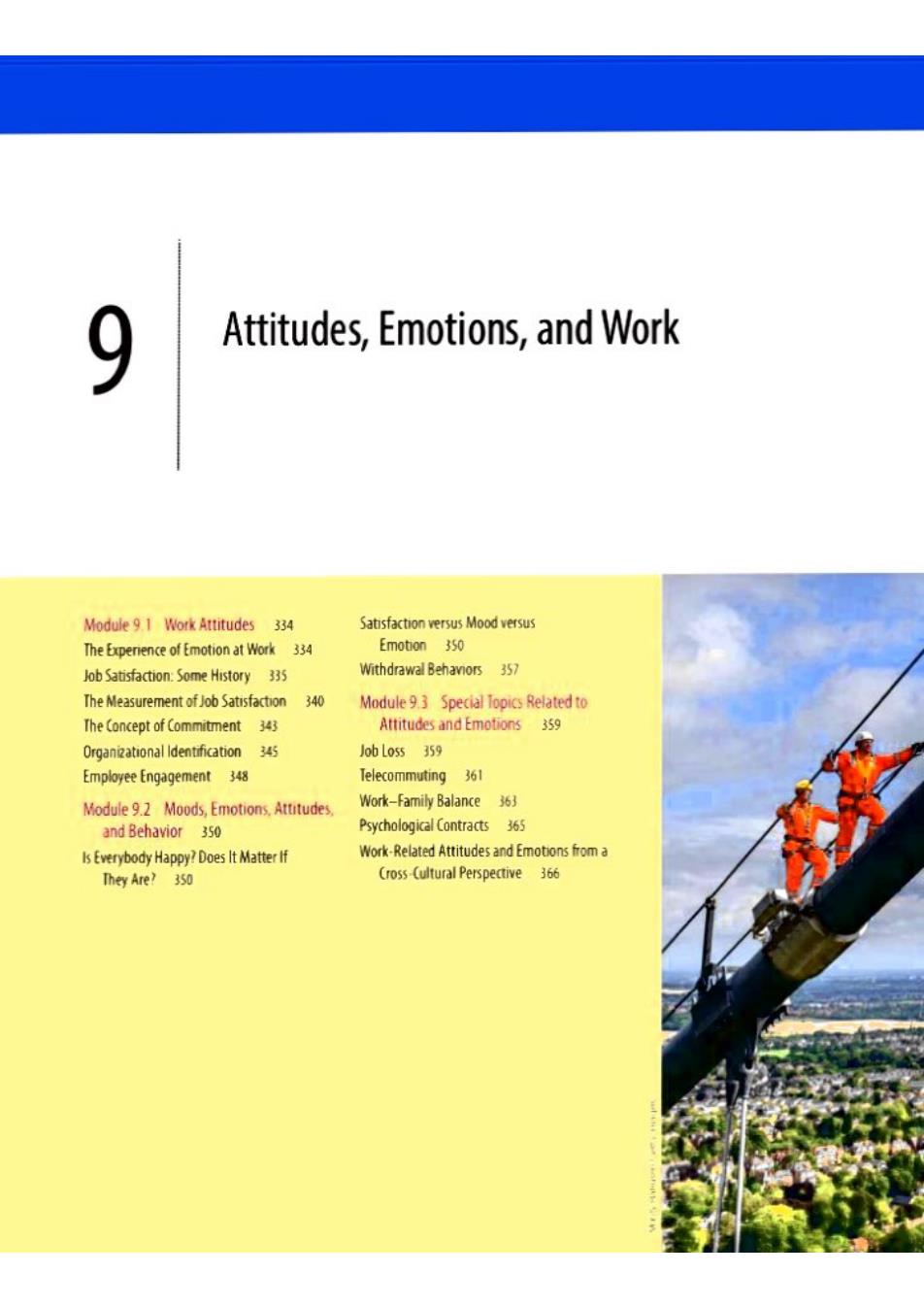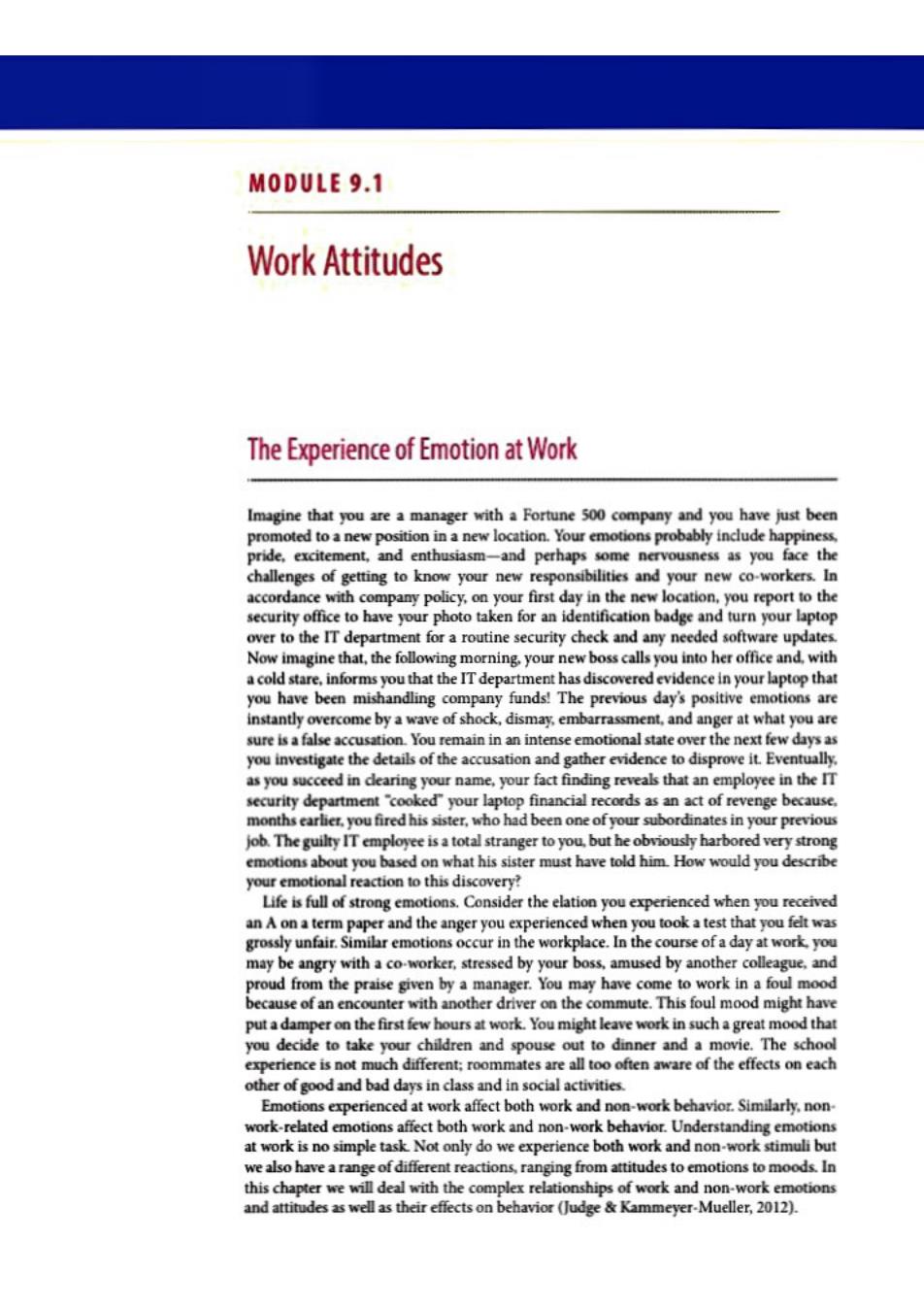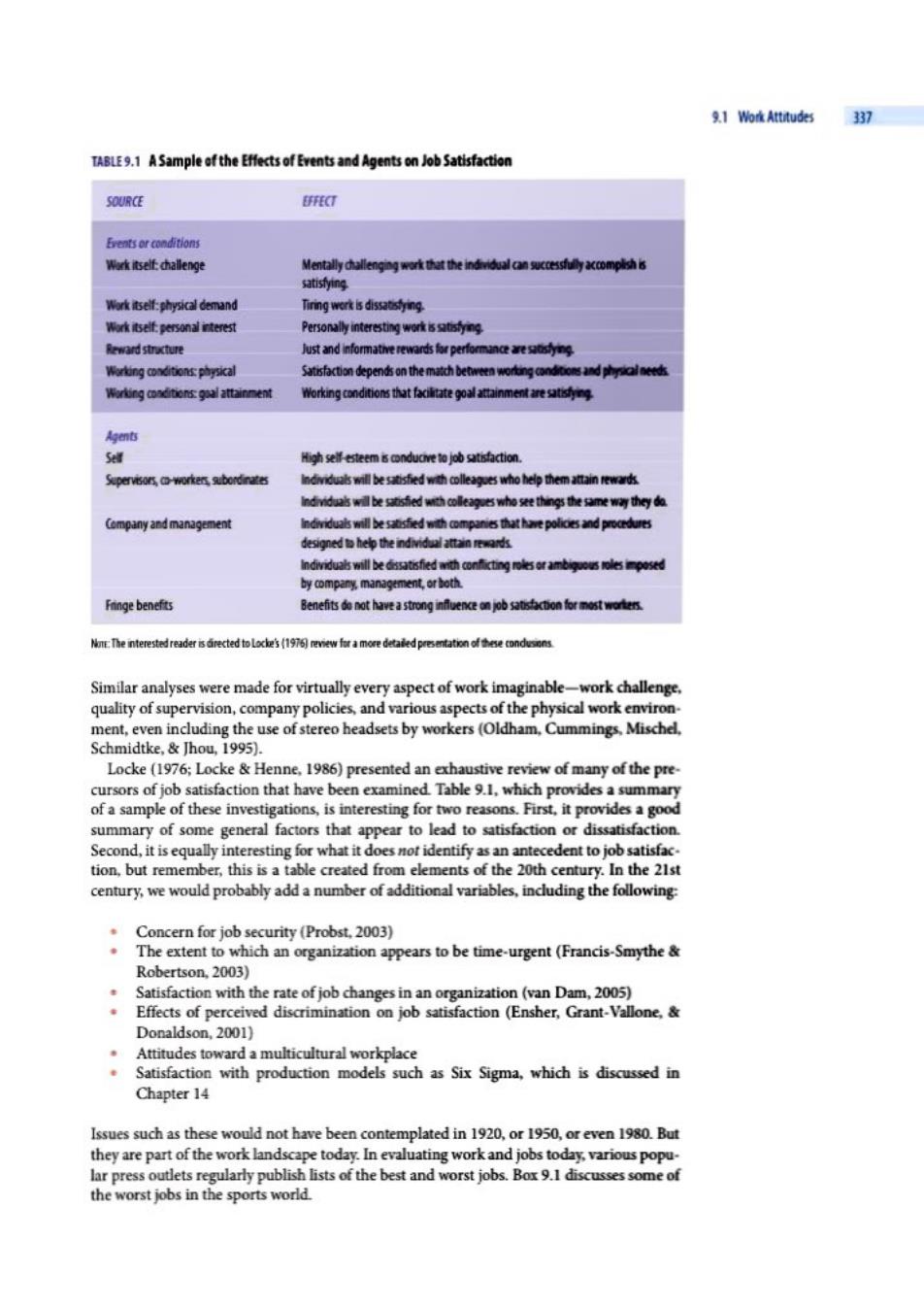
9 Attitudes,Emotions,and Work Module 9.1 Work Attitudes 334 Satisfaction versus Mood versus The Experience of Emotion at Work 334 Emotion 350 Job Satisfaction:Some History 335 Withdrawal Behavors 357 The Measurement of Job Satisfaction 340 Module93 Special Topics Related to The Concept of Commitment 343 Attitudes and Emotions 359 Organizational ldentification 345 Job Loss 359 Employee Engagement 348 Telecommuting 361 Module 9.2 Moods,Emotions.Attitudes Work-Family Balance 363 and Behavior 350 Psychological Contracts 365 Is Everybody Happy?Does It Matter lf Work-Related Attitudes and Emotions from a They Are?350 Cross-Cultural Perspective 366

MODULE 9.1 Work Attitudes The Experience of Emotion at Work Imagine that you are a manager with a Fortune 500 company and you have just been promoted to a new position in a new location.Your emotions probably include happiness. pride,excitement,and enthusiasm-and perhaps some nervousness as you face the challenges of getting to know your new responsibilities and your new co-workers.In accordance with company policy,on your first day in the new location,you report to the security office to have your photo taken for an identification badge and turn your laptop over to the IT department for a routine security check and any needed software updates. Now imagine that,the following morning.your new boss calls you into her office and,with a cold stare,informs you that the IT department has discovered evidence in your laptop that you have been mishandling company funds!The previous day's positive emotions are instantly overcome by a wave of shock,dismay,embarrassment,and anger at what you are sure is a false accusation.You remain in an intense emotional state over the next few days as you investigate the details of the accusation and gather evidence to disprove it.Eventually. as you succeed in dearing your name,your fact finding reveals that an employee in the IT security department cooked"your laptop financial records as an act of revenge because. months earlier.you fired his sister,who had been one of your subordinates in your previous job.The guilty IT employee is a total stranger to you,but he obviously harbored very strong emotions about you based on what his sister must have told him.How would you describe your emotional reaction to this discovery? Life is full of strong emotions.Consider the elation you experienced when you received an A on a term paper and the anger you experienced when you took a test that you felt was grossly unfair.Similar emotions occur in the workplace.In the course of a day at work.you may be angry with a co-worker,stressed by your boss,amused by another colleague,and proud from the praise given by a manager.You may have come to work in a foul mood because of an encounter with another driver on the commute.This foul mood might have put a damper on the first few hours at work.You might leave work in such a great mood that you decide to take your children and spouse out to dinner and a movie.The school experience is not much different:roommates are all too often aware of the effects on each other of good and bad days in class and in social activities. Emotions experienced at work affect both work and non-work behavior.Similarly.non. work-related emotions affect both work and non-work behavior.Understanding emotions at work is no simple task Not only do we experience both work and non-work stimuli but we also have a range of different reactions,ranging from attitudes to emotions to moods.In this chapter we will deal with the complex relationships of work and non-work emotions and attitudes as well as their effects on behavior (Judge Kammeyer-Mueller,2012)

9.1 Work Attitudes 335 Job Satisfaction:Some History The Early Period of Job Satisfaction Research In the mid-1920s,Elton Mayo,an Australian psychologist,introduced the concept of emo- tions into mainstream American I-0 psychology.He argued that factory work resulted in various negative emotions such as anger,fear,suspicion,lowered performance.and increased illness (Mayo,1923).This in turn led to the development of labor unions and worker unrest.(It was no accident that Mayo identified labor unions as the pathological result of job dissatisfaction.He had been actively opposing labor unions in his native Australia long before he arrived in the United States [Griffin,Landy,Mayocchi.2002]) Until this point,there had been little interest among psychologists or managers in the hap- piness of workers.It was assumed that workers cared only about wages and that as long as they were paid adequately,they would be happy.There were occasional surveys of worker satisfaction,but the surveys asked managers about the happiness of the workers rather than asking the workers themselves(Houser,1927). In the early 1930s,two very different research projects breathed life into the concept of job satisfaction.The first was a survey of all the working adults in a small town in Job satisfaction Pastive Pennsylvania.Robert Hoppock(1935)was interested in the answer to two questions How attu血e emotianal state happy were workers,and were workers in some occupations happier than workers in other wul相g from the apprasal occupations?He discovered that only 12 percent of workers could be classified as dissatis. fied.He also found wide variations among individuals within occupational groupings nev. ertheless,workers in some occupational groups (e.g.,professionals and managers)were,on the whole,happier than those in other categories (e.g.unskilled manual laborers).These findings suggested that both job-related and individual differences variables might influ- ence job satisfaction. The second research project was begun at the Hawthorne plant of the Western Electric Company in Cicero,Illinois,in the late 1920s (Roethlisberger Dickson.1939).As you may recall from our discussion in Chapter 1.the purpose of the Hawthorne studies was to examine the relationship between various physical aspects of the work environment (light. ing.workday length,the timing of rest breaks)and productivity.The findings suggested that the perceptions of workers had a greater effect on productivity than the actual physical working conditions. More surprisingly.they also suggested that with almost all of the experimental conditions the researchers introduced. production improved.When illumina- tion was reduced virtually to the level of candlelight,production improved.When the length of the workday was increased. production improved.When rest pauses were eliminated,production improved. These results were so unexpected that the researchers followed up the experiments with extensive interviews and an exami- nation of workers'diaries in an attempt to determine why the reduced illumination Job satisfaction is a positive emotonal state that can result from positive and longer work periods did not have the interactions with one's coworkers

336 Chapter9 Attitudes,Emotions,andWork hypothesized effect of reducing productivity.The researchers discovered that because of the experiment,the workers received considerably more attention from their supervisors and managers than they had previously.This increased attention was viewed positively by the workers and may explain why attitudes toward supervision improved.The improved atti. tudes of workers toward supervisors as a result of the increased attention appeared,in tum. to be responsible for the increase in productivity.This led to the introduction of a new term Hawthome effect into the literature of social and industrial psychology:the Hawthorne effect,meaning a A chang单n behavier道 change in behavior or attitudes that was the simple result of increased attention. 4td相that was the smpl地 At the time this research was reported,the general concusion drawn by I-0 psychologists result of inceased attention was that morale and production seemed to be closely linked.As we will see later in the chapter,this condlusion was wrong Nevertheless,both researchers and managers were quick to embrace this conclusion,and it has been hard to dispel.The Hawthome study results have been analyzed and reanalyzed,interpreted and reinterpreted,and many different theories have been proposed to account for the surprising results(Landsberger,1958).But one thing is beyond dispute Following dosely on the heels of Mayo's early research on the effect of factory work on emotions and the discovery of individual differences in satisfaction by Hoppock.the Hawthorne studies galvanized social scientists and gave impetus to the ttitudes Relativ时stable study of worker attitudes and the new construct of job satisfaction. fengs rbeliefs that are The years between 1935 and 1955 were very active for job satisfaction research,largely drected tward speafic because satisfaction was thought to be closely linked to two outcomes very important to w0气9所,次再 复ahw动布 industry:the prevention of labor unrest in the form of strikes,and productivity.The idea was that if an employer could keep worker morale high,the company would be strike-free and profitable.Most attempts to measure satisfaction asked workers about their most important needs and the extent to which those needs were being met.It was believed that the greater the extent to which important needs were met,the greater would be worker satisfaction (Schaffer,1953).In addition,social psychology was emerging during this period as a specialty within psychology.Social psychologists became very interested in atti- tudes of all sorts,and attitudes toward work represented a good integration of the theories of social psychologists with the interests of industrial psychologists. In the late 1950s,two reviews of the research conducted to that point came to very differ- ent condusions.Brayfield and Crockett(1955)concluded that there was little evidence of any substantial connection between satisfaction and performance.In contrast,Herzberg. Mausner,Peterson.and Capwell (1957)concluded that there was a connection between satisfaction and at least some work behaviors,particularly absenteeism and turnover.This led to the introduction ofone of the first modern theories of job satisfaction,the two-factor theory (Herzberg,Mausner,Snyderman,1959).Recall from Chapter 8 that,according to Herzberg.job satisfaction was the result of intrinsic job characteristics (eg.interesting work.challenge),whereas job dissatisfaction was the result of extrinsic characteristics(e.g.. pay.working conditions).Herzberg proposed that extrinsic factors satisfied "hyglene" needs and intrinsic factors satisfied "motivator"needs.This theory resulted in a flurry of activity.but eventually the theory was rejected on both logical and empirical grounds (Ewen.Smith.Hulin,Locke,1966:King.1970). Antecedents and Consequences of Job Satisfaction lob satisfaction research between 1935 and 1990 has been characterized as atheoretical (Brief&Weiss,2002).This criticism has been leveled in part because researchers depended on statistical analyses as a replacement for theory.They looked for correlations between reports of job satisfaction and observable aspects of work The best example is pay.Studies would examine the relationships among desired levels of pay,observed levels of pay,and reported job satisfaction(Sweeney McFarlin,2005:Williams,McDaniel,Nguyen,2006)

1%kAttitud好 337 TABLE9.1 ASample of the Effects of Events and Agents on Job Satisfaction SOURCE d Events or conditions Wkitsef:challenge Mentally alengngkthat the indiidual can sucesyaccomplishis satisfying Wark itself:physical demand Tirng wrk is dissatng Mork itselt ge都onal interes红t Personally interesting work is satistying Reward structure Just and informative rewards for perfommancer Working conditions physical Satisfaction depends on the math betweenwrngandphcd Warking conditions goal attainment Working conditions that facilitate goal attainment are satisying. 与anb Sel High self esteem is conducive to job satisfaction. Seperviso然,-worke蓝bcd钻 Individuals will be satisfied wth colleagues who help them attain rewards rdd当wb比5ied台colleag名who see things the samew海hy包 Company and management Individuals will be sasedh companies that hve polidesand procdures designed he中he individuattd Individuaswill betsfedthconcngrosoessed by company,management,or both Frnge benefts Benefitsd not have a stronginuenenjobsatforstws N:The interested reader is directed toLocke's(197)review for a more detaled peesentation of these condusns Similar analyses were made for virtually every aspect of work imaginable-work challenge, quality of supervision,company policies,and various aspects of the physical work environ. ment,even including the use of stereo headsets by workers(Oldham.Cummings,Mischel. Schmidtke,Thou.1995). Locke (1976;Locke Henne,1986)presented an exhaustive review of many of the pre- cursors of job satisfaction that have been examined.Table 9.1,which provides a summary of a sample of these investigations,is interesting for two reasons.First,it provides a good summary of some general factors that appear to lead to satisfaction or dissatisfaction. Second,it is equally interesting for what it does not identify as an antecedent to job satisfac. tion,but remember,this is a table created from elements of the 20th century.In the 21st century,we would probably add a number of additional variables,including the following: Concern for job security (Probst.2003) The extent to which an organization appears to be time-urgent(Francis-Smythe Robertson,2003) Satisfaction with the rate of job changes in an organization(van Dam,2005) Effects of perceived discrimination on job satisfaction(Ensher,Grant-Vallone, Donaldson,2001) Attitudes toward a multicultural workplace Satisfaction with production models such as Six Sigma,which is discussed in Chapter 14 Issues such as these would not have been contemplated in 1920,or 1950,or even 1980.But they are part of the work landscape today.In evaluating work and jobs today,various popu- lar press outlets regularly publish lists of the best and worst jobs.Box9.1 discusses some of the worst jobs in the sports world